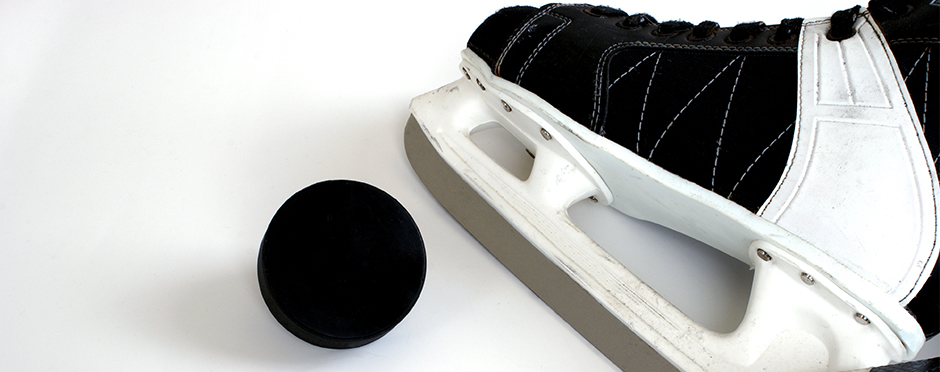
Off-Season Training: A Hockey Perspective
1 CommentOff-season training for any sport is an important part of an athlete’s development. During the off-season, athletes make gains on their conditioning, endurance, strength, balance and/or speed to compete at a higher level within the sport of their choice.
How one chooses to spend their time in the off-season can impact whether or not they make the team and possibly continue to play the sport long term. Quite often athletes or parents misuse this period with the intention of making themselves or their children better. In fact, many athletes participate in a single sport year-round without the mental and physical contributions afforded to them by the off-season.
Mentally, these individuals are susceptible to the effects of overtraining, such as burnout, social isolation and overdependence on personal, sport-specific goals (making the team). These issues can be detrimental to the athlete’s ability to continue a healthy lifestyle as an adult 1,2,3.
Physically, most kinesiologists would agree that limiting children to one sport might also impair their ability to acquire a variability and proficiency in motor skills. For example, individuals that participate in “Long Jump” during track season may learn to use their arms and torso more efficiently to propel themselves when skating. This may translate to an improvement in an individual’s hockey stride and thus an improvement in their game. In addition to motor learning concerns, the physical breakdown of tissues due to repetitive stressors in single-sport training could lead to joint injuries that impact an athlete’s performance4.
Although a single sport versus a multi-sport training approach does not show a specific causation of injury, a lack of flexibility, strength and balance can be magnified due to the repetitive stressors associated with single sport training. Below are some examples of orthopedic injuries associated with repetitive motions:
- Lateral epicondylitis (Tennis elbow)
- Medial epicondylitis (Golfer’s elbow)
- Rotator cuff tendinitis and impingement (Swimmer’s shoulder)
- Spondylolysis (repetitive trunk extension)
- Sinding-Larsen-Johansson disease
- Shin splints
- Sever’s disease
- Osteochondritis dissecans
- Osgood-Schlatter’s Disease
- Little leaguers’ elbow or shoulder
- Patellar tendonitis (Jumper’s knee)
The question then, is how should an athlete train in the off-season to support their “main” sport? There is not one specific answer, but there are factors that can be highlighted in one’s training to improve their overall performance. By structuring an athlete’s exertion and rest periods during training, and monitoring their heart rate, a variety of activities can be modified from an energy production perspective to compliment a specific sport.
An athlete’s body derives its energy from one of three particular systems, including the ATP/CP system, the Glycolysis system and the Oxidative system5. These systems operate based on the work and duration of the body’s activity. As the athlete performs training activities or sport-related activities, the body is “shifting” from one system to the next to ensure it has the proper energy levels to operate. Over time, an athlete’s training intensities can be fine-tuned to mimic the demands required for a specific sport, such as ice hockey. Figure one represents the utilization of each of these energy systems during different sports and can be used as a guide toward the development of an off-season workout regimen. Interestingly, soccer utilizes each of the three-energy systems in a similar fashion to ice hockey, and has been a common off-season training method in Europe for years.
Percentage of Each Energy System Used During Sports Activities
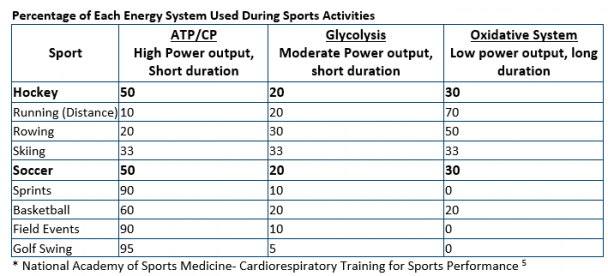 While most athletes engage in organized sports, others may seek to improve their sport-specific fitness through personalized cardiovascular training, weight training or interval training. Regardless of the training method, individuals can directly measure their workout intensity by calculating and tracking their heart rate. Tracking the heart rate can directly measure an athlete’s overall work output while personalizing their exercise regimen to a specific sport. Explosive strength, cardiovascular endurance and functional strength training are all forms of training that can be tailored accordingly with an emphasis on a target heart rate zone and a specific duration of the activity. Below is a quick description of a three-zone approach that can be utilized from a hockey training perspective. The colors correspond to the two training examples below provided by the National Academy of Sports Medicine5.
While most athletes engage in organized sports, others may seek to improve their sport-specific fitness through personalized cardiovascular training, weight training or interval training. Regardless of the training method, individuals can directly measure their workout intensity by calculating and tracking their heart rate. Tracking the heart rate can directly measure an athlete’s overall work output while personalizing their exercise regimen to a specific sport. Explosive strength, cardiovascular endurance and functional strength training are all forms of training that can be tailored accordingly with an emphasis on a target heart rate zone and a specific duration of the activity. Below is a quick description of a three-zone approach that can be utilized from a hockey training perspective. The colors correspond to the two training examples below provided by the National Academy of Sports Medicine5.
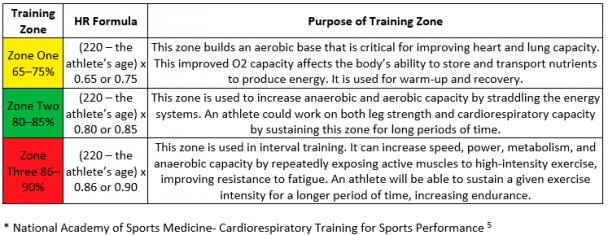 Training to Improve Recovery in Ice Hockey
Training to Improve Recovery in Ice Hockey
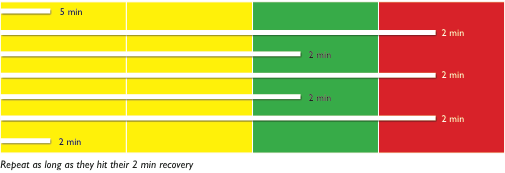
* National Academy of Sports Medicine- Cardiorespiratory Training for Sports Performance 5
High Intensity of Cardiac Training in Ice Hockey
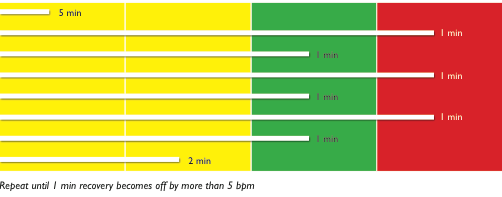
* National Academy of Sports Medicine- Cardiorespiratory Training for Sports Performance 5
It is important to note that any exercise regimen can have benefits when performed correctly and when tailored to the right individual. Prior to performing any exercise regimen, it is recommended that athletes check with their physician or physical therapist to discuss overall safety and ways to minimize injury. Click below to schedule an appointment with an Athletico physical therapist.
Click to Request an Appointment Today
The Athletico blog is an educational resource written by Athletico employees. Athletico bloggers are licensed professionals who abide by the code of ethics outlined by their respective professional associations. The content published in blog posts represents the opinion of the individual author based on their expertise and experience. The content provided in this blog is for informational purposes only, does not constitute medical advice and should not be relied on for making personal health decisions.
References:
1-Brenner JS. Overuse injuries, overtraining, and burnout in child and adolescent athletes. Pediatrics. 2007;119(6):1242–1245.
2-Malina RM. Early sport specialization: roots, effectiveness, risks. Curr Sports Med Rep. 2010;9(6):364–371.
3-Wiersma LD. Risks and benefits of youth sport specialization: Perspectives and recommendations. Pediatr Exerc Sci. 2000;12(1):13–22.
4- Fransen J, Pion J, Vandendriessche J, et al. Differences in physical fitness and gross motor coordination in boys aged 6-12 years specializing in one versus sampling more than one sport. J Sport Sci. 2012;30(4):379–386.
5- Robbins, P. (n.d.). Cardiorespiratory Training for Fitness – NASM eLearning. Retrieved July 3, 2016, from http://learn.nasm.org/courses/Cardio_Fit/Cardio for Fitness LowRes.pdf.


1 Comment
Yannick Balk
Interesting overview with some nice suggestions. One important thing to keep in mind, however, is the role of off-season mental recovery. Spending some time away from sport can help athletes to stay motivated and mentally sharp. While working on one’s fitness, athletes should also think about non-sport activities that they simply enjoy. Otherwise, with most sports becoming a year-round endeavour, overuse injuries and overtraining are simply a matter of time.